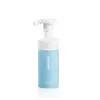What's inside
What's inside
 Key Ingredients
Key Ingredients

 Benefits
Benefits

 Concerns
Concerns

 Ingredients Side-by-side
Ingredients Side-by-side

Water
Skin ConditioningGlycerin
HumectantPolyglycerin-10
HumectantSodium Lauroamphoacetate
CleansingDisodium Laureth Sulfosuccinate
CleansingCocamidopropyl Betaine
CleansingPEG-8
HumectantSodium Chloride
MaskingDisodium Lauroamphodiacetate
CleansingPolyquaternium-7
Trehalose
HumectantLauryl Betaine
CleansingSodium Methyl Cocoyl Taurate
Cleansing1,2-Hexanediol
Skin ConditioningChlorphenesin
AntimicrobialEthylhexylglycerin
Skin ConditioningDisodium EDTA
Methylpropanediol
SolventSodium Hyaluronate
HumectantNiacinamide
SmoothingPanthenol
Skin ConditioningStephania Tetrandra Root Extract
Skin ConditioningHydrolyzed Hyaluronic Acid
HumectantHydroxypropyltrimonium Hyaluronate
Sodium Acetylated Hyaluronate
HumectantHyaluronic Acid
HumectantHydrolyzed Sodium Hyaluronate
Skin ConditioningPotassium Hyaluronate
Skin ConditioningSodium Hyaluronate Crosspolymer
HumectantSodium Hyaluronate Dimethylsilanol
HumectantCeramide EOP
Skin ConditioningCeramide AP
Skin ConditioningCeramide NP
Skin ConditioningCarica Papaya Fruit Extract
Skin ConditioningAnanas Sativus Fruit Extract
Skin ConditioningDiospyros Kaki Peel Extract
Skin ConditioningPhenoxyethanol
PreservativeWater, Glycerin, Polyglycerin-10, Sodium Lauroamphoacetate, Disodium Laureth Sulfosuccinate, Cocamidopropyl Betaine, PEG-8, Sodium Chloride, Disodium Lauroamphodiacetate, Polyquaternium-7, Trehalose, Lauryl Betaine, Sodium Methyl Cocoyl Taurate, 1,2-Hexanediol, Chlorphenesin, Ethylhexylglycerin, Disodium EDTA, Methylpropanediol, Sodium Hyaluronate, Niacinamide, Panthenol, Stephania Tetrandra Root Extract, Hydrolyzed Hyaluronic Acid, Hydroxypropyltrimonium Hyaluronate, Sodium Acetylated Hyaluronate, Hyaluronic Acid, Hydrolyzed Sodium Hyaluronate, Potassium Hyaluronate, Sodium Hyaluronate Crosspolymer, Sodium Hyaluronate Dimethylsilanol, Ceramide EOP, Ceramide AP, Ceramide NP, Carica Papaya Fruit Extract, Ananas Sativus Fruit Extract, Diospyros Kaki Peel Extract, Phenoxyethanol
Water
Skin ConditioningGlycerin
HumectantCoco-Betaine
CleansingMorinda Citrifolia Fruit Extract
Skin ConditioningPentylene Glycol
Skin ConditioningXanthan Gum
EmulsifyingSodium Chloride
MaskingCoco-Glucoside
CleansingGlyceryl Caprylate
EmollientCaprylyl Glycol
EmollientDecyl Glucoside
CleansingBetaine
HumectantButylene Glycol
HumectantBisabolol
MaskingSodium Cocoyl Isethionate
Cleansing1,2-Hexanediol
Skin ConditioningDisodium EDTA
Anthemis Nobilis Flower Extract
MaskingCitric Acid
BufferingQuillaja Saponaria Bark Extract
CleansingEthylhexylglycerin
Skin ConditioningAllantoin
Skin ConditioningCaffeine
Skin ConditioningCaprylic/Capric Triglyceride
MaskingLeuconostoc/Radish Root Ferment Filtrate
AntimicrobialLactobacillus/Soybean Ferment Extract
Skin ConditioningLactobacillus Ferment
Skin ConditioningLactobacillus/Acerola Cherry Ferment
Skin ProtectingLactococcus Ferment
Skin ConditioningBifida Ferment Filtrate
Skin ConditioningLactococcus Ferment Lysate
Skin ConditioningLactobacillus/Punica Granatum Fruit Ferment Extract
Skin ConditioningLactobacillus Ferment Lysate
Skin ConditioningHydrogenated Lecithin
EmulsifyingCeramide NP
Skin ConditioningWater, Glycerin, Coco-Betaine, Morinda Citrifolia Fruit Extract, Pentylene Glycol, Xanthan Gum, Sodium Chloride, Coco-Glucoside, Glyceryl Caprylate, Caprylyl Glycol, Decyl Glucoside, Betaine, Butylene Glycol, Bisabolol, Sodium Cocoyl Isethionate, 1,2-Hexanediol, Disodium EDTA, Anthemis Nobilis Flower Extract, Citric Acid, Quillaja Saponaria Bark Extract, Ethylhexylglycerin, Allantoin, Caffeine, Caprylic/Capric Triglyceride, Leuconostoc/Radish Root Ferment Filtrate, Lactobacillus/Soybean Ferment Extract, Lactobacillus Ferment, Lactobacillus/Acerola Cherry Ferment, Lactococcus Ferment, Bifida Ferment Filtrate, Lactococcus Ferment Lysate, Lactobacillus/Punica Granatum Fruit Ferment Extract, Lactobacillus Ferment Lysate, Hydrogenated Lecithin, Ceramide NP
 Reviews
Reviews

Ingredients Explained
These ingredients are found in both products.
Ingredients higher up in an ingredient list are typically present in a larger amount.
1,2-Hexanediol is a synthetic liquid and another multi-functional powerhouse.
It is a:
- Humectant, drawing moisture into the skin
- Emollient, helping to soften skin
- Solvent, dispersing and stabilizing formulas
- Preservative booster, enhancing the antimicrobial activity of other preservatives
Ceramide NP is a type of ceramide and formally known as ceramide 3.
Ceramides are intercellular lipids naturally found in our skin that bonds dead skin cells together to create a barrier. They are known for their ability to hold water and thus are a great ingredient for dry skin.
Ceramides are an important building block for our skin barrier. A stronger barrier helps the skin look more firm and hydrated. By bolstering the skin ceramides act as a barrier against irritating ingredients. This can help with inflammation as well.
If you would like to eat ceramides, sweet potatoes contain a small amount.
Read more about other common types of ceramides here:
Ceramide AP
Ceramide EOP
Disodium EDTA plays a role in making products more stable by aiding other preservatives.
It is a chelating agent, meaning it neutralizes metal ions that may be found in a product.
Disodium EDTA is a salt of edetic acid and is found to be safe in cosmetic ingredients.
Learn more about Disodium EDTAEthylhexylglycerin (we can't pronounce this either) is commonly used as a preservative and skin softener. It is derived from glyceryl.
You might see Ethylhexylglycerin often paired with other preservatives such as phenoxyethanol. Ethylhexylglycerin has been found to increase the effectiveness of these other preservatives.
Glycerin is already naturally found in your skin. It helps moisturize and protect your skin.
A study from 2016 found glycerin to be more effective as a humectant than AHAs and hyaluronic acid.
As a humectant, it helps the skin stay hydrated by pulling moisture to your skin. The low molecular weight of glycerin allows it to pull moisture into the deeper layers of your skin.
Hydrated skin improves your skin barrier; Your skin barrier helps protect against irritants and bacteria.
Glycerin has also been found to have antimicrobial and antiviral properties. Due to these properties, glycerin is often used in wound and burn treatments.
In cosmetics, glycerin is usually derived from plants such as soybean or palm. However, it can also be sourced from animals, such as tallow or animal fat.
This ingredient is organic, colorless, odorless, and non-toxic.
Glycerin is the name for this ingredient in American English. British English uses Glycerol/Glycerine.
Learn more about GlycerinChances are, you eat sodium chloride every day. Sodium Chloride is also known as table salt.
This ingredient has many purposes in skincare: thickener, emulsifier, and exfoliator.
You'll most likely find this ingredient in cleansers where it is used to create a gel-like texture. As an emulsifier, it also prevents ingredients from separating.
There is much debate on whether this ingredient is comedogenic. The short answer - comedogenic ratings don't tell the whole story. Learn more about comegodenic ratings here.
The concensus about this ingredient causing acne seems to be divided. Research is needed to understand if this ingredient does cause acne.
Scrubs may use salt as the primary exfoliating ingredient.
Learn more about Sodium ChlorideWater. It's the most common cosmetic ingredient of all. You'll usually see it at the top of ingredient lists, meaning that it makes up the largest part of the product.
So why is it so popular? Water most often acts as a solvent - this means that it helps dissolve other ingredients into the formulation.
You'll also recognize water as that liquid we all need to stay alive. If you see this, drink a glass of water. Stay hydrated!
Learn more about Water